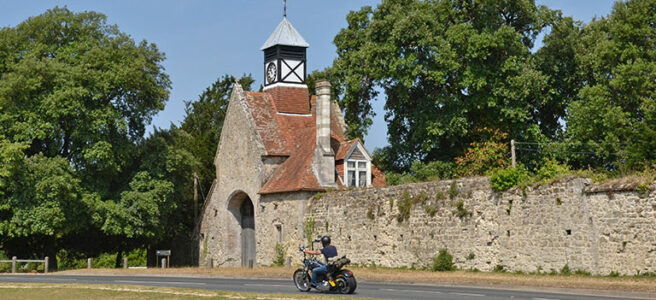The New Forest National Park is a popular tourist destination all year round, where visitors enjoy the delights of its magnificent landscapes, picturesque villages, and abundant wildlife. The 220 square miles of woodland, heathland and moor provide a multitude of historic hamlets, villages and destinations for guests looking to escape the hustle and bustle of everyday life.
Behind this national treasure, in all of its unspoilt glory, lies a remarkable 1000 year history of hunting and industry that has secured its unique preserved status to this day. While much is written about the delights the forest has to offer friends, families and romantics who enjoy nature, a fantastic food and pub scene, attractions and the great outdoors, what does the forest have to offer to history lovers? Unlike the surrounding historical landmarks of Salisbury, Winchester and Southampton, where history abounds from every corner, the attractions of bygone years in the New Forest are distributed in some of the most unlikely of locations.
If history and heritage is your passion, or you simply wish to introduce a sprinkling of history into your forest break, read on for ideas and suggestions of locations to visit:
11th and early 12th Century (The Normans): The Rufus Stone
View this post on Instagram
Let’s begin in the year 1100. The country is beginning to settle down to life under Norman rule following the invasion and subsequent occupation of William the Conqueror in 1066. William famously first established the New Forest as a royal hunting ground in 1079, where it provided a vast designated area for selected royal guests to hunt the abundant deer and boar.
Following William’s death in 1087, the crown passed to his son, Rufus (William II), who by all accounts was an unpopular character. Despite his unremarkable reign, Rufus will be forever immortalised within the New Forest due to the events surrounding his death. Rufus was famously killed during a hunting expedition with an arrow through his heart – it is still debated whether the incident was an accident or malicious intent. While we will never really know the full story, it is documented that the perpetrator – Sir Walter Tyrell, quickly fled the scene and today the name ‘Tyrell’ appears on a number of place names throughout the Forest. Take a trip to Minstead to visit the Rufus Stone, a monument that marks the alleged spot where Rufus met his grisly end.
Find New Forest Cottages close to Minstead
Late 12th Century (Early Plantagenet): The Mizmaze
View this post on Instagram
As we move forward in history from the Normans, we can start to hunt out some of the very few medieval sites within the New Forest. The once numerous hunting lodges have long since perished. However, just north of Fordingbridge you’ll find the Mizmaze – circa 12th or 13th Century – an ornate turf maze which has been carved into a secluded hilltop, close to nearby Breamore House (see later travels). It is thought that the site was once an extension to the nearby Priory, where it served as part of a penance ritual performed by resident monks. It is believed that monks would shuffle tortuously around the maze on their knees while reciting Bible scriptures. It is now a tranquil site where it’s easy to float back in time and imagine the chants and shuffles of the monks.
Find New Forest Cottages close to Fordingbridge
13th Century (Plantagenet Period): Beaulieu Abbey
View this post on Instagram
Perhaps the best evidence of medieval life in the New Forest can be found within the ruins of the once magnificent Beaulieu Abbey. Founded in 1203 by King John and finally completed in 1246 within the reign of Henry III, Beaulieu Abbey was once a truly remarkable landmark.
Sadly, the destruction of the abbey was ordered in 1538 following Henry VIII’s dissolution of the monasteries, and its splendour lost to the annals of time. Interestingly, much of the Abbey’s masonry was taken to assist in the construction of nearby Calshot Castle (see our next destination).
Today, all that remains of the Abbey is the monk’s refectory and a set of dramatic ghostly ruins. The charm of the site however is not lost, still drawing thousands of visitors every year as part of the Beaulieu National Motor Museum and Palace House visitors’ package. It is easy to visualise the monks silently gathering herbs form the Abbey garden to the sound of prayer drifting through the cloisters.
Find New Forest Cottages close to Beaulieu
1540 (Tudor Period): Calshot Castle
View this post on Instagram
We are now in the year 1540. It is the midpoint of the Tudor dynasty, King Henry VIII is enjoying his 5th marriage and only has a few short years left on the throne. Following the dissolution of the monasteries and Henry’s split with Rome, a deep paranoia is developing about potential coastal attacks from Spanish and French forces. To guard against this threat, Henry developed a series of strategically placed defensive forts along the south coast of England.
Calshot Castle is located close to Exbury on the south east coast of the New Forest National Park at the end of Calshot spit, in an optimal position to ward off threats from Southampton Water. Its unusual circular design provided excellent deflective defence from cannon balls, with up to three metre thick walls making it almost impenetrable. Nested within the moat and surrounding wall is an impressive three-story keep which is open for exploration by visitors.
During its heyday, Calshot Castle once had a garrison of 15 soldiers and an impressive 36 cannon battery; remarkably the castle remained in active use well into the 20th Century. Today, the fort sits inactive among the multitude of water sports enthusiasts and yachts for which Calshot has become synonymous.
Find New Forest Cottages close to Exbury
1583 (Late Tudor Period / Elizabethan Times): Breamore House
View this post on Instagram
Our journey takes us into Elizabethan England, and to Breamore House, situated to the north of the New Forest about eight miles south of Salisbury. Built in 1583, Breamore House is magnificent and typical of the architecture at this time, with its elegant windows and ornate chimneys. Standing in the gardens of the house, it is easy to imagine the wealthy Elizabethan occupants walking the grounds, befitted in their ornate tailored garments, elaborate ruffs and flowing gowns.
Today Breamore is a private country house that opens its doors to visitors between May and October (check availability). Visitors can take a guided tour of the house, enjoy a refreshment at the tea-rooms and explore the countryside museum.
Find New Forest Cottages close to Fordingbridge
In part 2 of our time traveller’s itinerary to the New Forest we will explore the New Forest from the 17th Century until the present day.
Take a look at our full portfolio of more than 130 New Forest Cottages.

